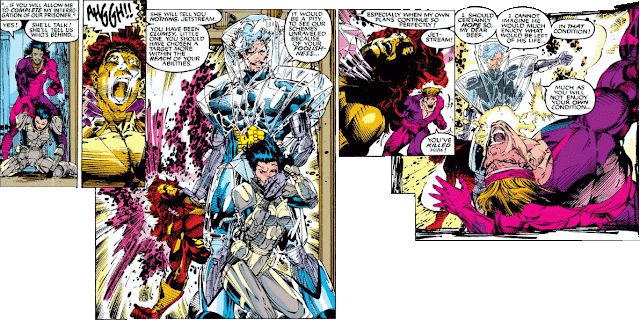Since we haven't had enough merciless, brutal killing of mutants for one week, let's see who else will have their head on the chopping block, as Marvel continues with its unofficial shift in direction toward bloodlust following its introduction of the Marauders, a mercenary group that invaded the Morlock tunnels and slaughtered hundreds of men, women and children. Let's jump ahead a bit to late-1991, where the company is celebrating another anniversary--fifty years of Captain America, a hero who would likely be appalled at how conflicts with super-villains now resemble the bloody battlefields of World War II that are seared into his memories. In the Marvel comics of the 1990s, you'd better be packing a piece--because the company has decided that attitude, a body count, and the BUDDA-BUDDA-BUDDA of high-tech weaponry are what readers are looking for in their comics.
We pick things up as a new team of X-Men is introduced, along with a new creative team to chart its course.
As for which characters are going to shortly be in need of tombstones:
They're even pictured as corpses here--how's that for adding insult to injury?
The Hellions, the mutant students at the Massachusetts Academy which the Hellfire Club subsidizes, have changed their roster slightly since their introduction in The New Mutants; still as cocky as ever, which makes their deaths even more regrettable. They're fated to be caught in a power struggle going on between two factions of the group known as the Upstarts, whose members attempt to kill as many mutants as possible and then collect points based on the dead mutant's importance, power, and skills. (Great, now it's a game. Kids, please don't try this at home.) Shinobi Shaw, son of Sebastian Shaw, leader of the Hellfire Club, is currently in the position of King; while a time traveller, Trevor Fitzroy, is competing to replace him. Making matters worse is that it appears both men have access to the use of Sentinels, though Fitzroy's are more advanced since he can transport them from the future.
Fitzroy is an aggressive competitor, who moves to match Shinobi's kill of his own father by attempting to kill other members of the Hellfire Club. He first targets the cyborg, Donald Pierce, operating in Australia with a group known as the Reavers.
The attack is nearly successful; but while the Reavers fall to the Sentinels, Pierce escapes via a "gateway" to New York and the Hellfire Club. It's a tactical blunder, since it leads both Fitzroy and the Sentinels to a gathering at the Club, where Emma Frost (the White Queen), who's recently become a target of assassination attempts, has summoned the X-Men to gain their assistance. As usual, the Club is hosting a posh black tie event when the X-Men arrive; but tensions quickly mount for the team as well as Frost and the Hellions when Frost is attacked by and defeats yet another assassin and prepares to interrogate the prisoner, as only she can.
Yet Fitzroy is quick to arrive to retrieve his operative, and his power proves formidable in nonchalantly eliminating anyone who stands in his way, despite the X-Men going into action to prevent the deaths that quickly follow.
(Does anyone want to tell Storm that she squandered that fraction-of-a-second window by saying all those words?)
Fitzroy and the Sentinels make a clean sweep of the operation, capturing the rest of the Hellions as well as the White Queen and then detouring to Shinobi's apartment in New York, where he deposes Shinobi by force (gruesomely, it probably goes without saying)--after which he and the Sentinels return to their complex in the Arctic, where he prepares to increase his power base by killing the rest of the Hellions and thus gaining the raw power to bring more of his allies back through time to join him. The deaths start with Tarot--apparently only disabled in the prior attack, although these Sentinels don't strike me as being the type to hold back when they're targeting someone for termination. Her power (along with that of the two prior Hellion deaths) allows Fitzroy to summon a small group of compatriots through another time portal.
Yet the X-Men then arrive in force to continue the battle and hopefully recover the prisoners; at least, I'm assuming they're interested in recovering the prisoners, since the story scripted by John Byrne only has them concerned with recovering the psychic essence of Jean Grey, who transferred that essence to the White Queen when the Sentinels zeroed in on her. Byrne actually does a nice job of scripting here, and has a good feel for the characters; unfortunately, with all the shooting and slaying, it's difficult to account for and follow up with everyone with any sense of continuity. (For instance, Jean transferring her thoughts to Frost's mind wouldn't prevent her body from being killed by the Sentinels, would it? And how does Fitzroy manage to reprogram the Sentinels he conscripts?)
The team is considerably more effective against the Sentinels than previously, so much so that Fitzroy must act to bring many more of his forces through time in order to keep the base from falling. Unfortunately, that means ruthlessly slaying the remainder of the captives, including the Hellions, to acquire the necessary power.
The Hellions would, down the road, eventually reform with new membership (including a resurrected Tarot--don't ask me how), while the X-Men's future stories would go on to deploy enough firepower to make even Firepower raise an eyebrow. On another note, this story would also feature the first appearance of a character who would eventually become a new X-Man:
As well as including a two-page promotion announcing a brand new Marvel fan club, which would be fated to become a casualty without, for once, a shot being fired.














1 comment:
...so in the future, everyone has terrible hair?
Post a Comment